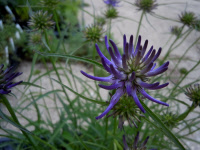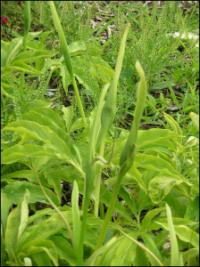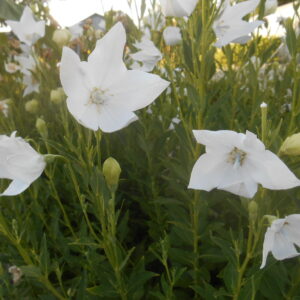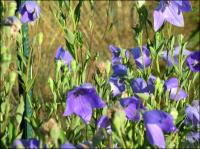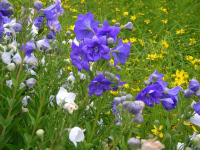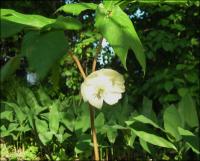Shop
Showing 569–576 of 788 results
-
Phyteuma scheuchzeri Horned rampion Z 5-8
Clusters of globe-shaped, blue-purple flowers with petals resembling tiny horns or curved spikes bloom in June-July. “…(W)hen exposed only to the morning sun, will keep long in bloom.” Curtis’ Botanical Magazine 1815-6.
Clusters of globe-shaped, blue-purple flowers with petals resembling tiny horns or curved spikes bloom in June-July. “…(W)hen exposed only to the morning sun, will keep long in bloom.” Curtis’ Botanical Magazine 1815-6.
Size: 8-12” x 12”
Care: sun in well-drained soil
Native: Mountains of Switzerland and “Piemont.”Collected in late 1700’s. The name Phyteuma is from Greek meaning “a plant.”
-
Pimpinella major ‘Rosea’ Greater burnet, Cow parsley Z 5-8
Like Queen Ann’s lace but fear its invasion? Here’s a look-alike, pink perennial that won’t take over. Its many upright stems, with lacy foliage, each support a pink umbel. Blooms in early to mid-summer.
Like Queen Ann’s lace but fear its invasion? Here’s a look-alike, pink perennial that won’t take over. Its many upright stems, with lacy foliage, each support a pink umbel. Blooms in early to mid-summer.
Size: 3’-4’ x 2’
Care: sun to part-shade in moist well-drained soil
Native: Europe and Caucasus
Wildlife Value: attracts bees and butterflies. Its flowers are rich in both pollen and nectar.First described in literature in 1812 by German botanist David Heinrich (1760-1846) in Nouvelle Flore des Environs de Paris. He named it Pimpinella rubra. Since then botanists decided it’s a cultivar of the white-flowered Pimpinellla major and renamed it.
-
Pinellia pedatisecta Green dragon Z 5-8
Green modified leaf (spath) curls around very thin, tall, graceful inflorescence (spadix) much like a primitive jack-in-the-pulpit. Grow this & hear your friends ask "what is that?"
ARCHIVED
Note: This is a plant not currently for sale. This is an archive page preserved for informational use.
Green modified leaf (spath) curls around very thin, tall, graceful inflorescence (spadix) much like a primitive jack-in-the-pulpit. Grow this & hear your friends ask “what is that?”
Size: 18" x 8"
Care: easy to grow in sun to part shade in moist to moist well-drained soil
Native: N & W ChinaIn Chinese called “Hu Zhang.” In Chinese medicine used to remedy ailments of the spleen, gallstones & coughs. Raw plant is toxic but neutralized by drying. Collected for western gardens by 1858.
-
Platycodon grandiflorus albus Balloon flower Z 3-9
Balloon shaped buds as though puffed with air, open to white, five-petal bells from mid-summer to early fall.
Balloon shaped buds as though puffed with air, open to white, five-petal bells from mid-summer to early fall.
Size: 24" x 12"
Care: Sun to part shade in moist well-drained soil, heat and drought tolerant. Deadhead for rebloom.
Native: Eastern Asia
Wildlife Value: attracts hummingbirds, bees & butterflies
Awards: England's Royal Horticultural Society Award of Garden Merit.Platycodon is Greek from platys meaning “broad” and kodon meaning “bell”, referring to the shape of the flower. Cultivated in China for hundreds of years where it is called Jie-geng. The Chinese used the root boiled to cure a chill in the stomach. Mentioned in Man’yoshu, a Japanese anthology of poems written in the 8th century. German botanist Johann Gmelin first collected this in Siberia in 1754. Gmelin’s Siberian mission, sponsored by Catherine the Great, took 10 years and nearly killed him. Gmelin introduced it to European gardens by 1782. Robert Fortune found the white form in a nursery near Shanghai and sent it to England in 1845.
-
Platycodon grandiflorus Balloon flower Z 3-9
Balloon shaped buds as though puffed with air, open to blue, five-petal bells from mid-summer to early fall.
Balloon shaped buds as though puffed with air, open to blue, five-petal bells from mid-summer to early fall.
Size: 24" x 12"
Care: Sun to part shade in moist well-drained soil, heat and drought tolerant. Deadhead for rebloom.
Native: Eastern Asia
Wildlife Value: attracts butterflies, bees & hummingbirds
Awards: Received England’s Royal Horticultural Society Award of Merit.Platycodon is Greek from platys meaning “broad” and kodon meaning “bell”, referring to the shape of the flower. Cultivated in China for hundreds of years where it is called Jie-geng. The Chinese used the root boiled to cure a chill in the stomach. Mentioned in Man’yoshu, a Japanese anthology of poems written in the 8th century. German botanist Johann Gmelin first discovered P. grandiflorus in Siberia in 1754. Gmelin’s Siberian mission, sponsored by Catherine the Great, took 10 years and nearly killed him. Gmelin introduced it to European garden cultivation by 1782. Cultivated in the U.S. since the 1800’s.
-
Platycodon grandiflorus double Double Balloon flower Z 3-9
Balloon shaped buds opening to double blue bells from mid-summer to early fall. Deadhead for rebloom.
ARCHIVED
Note: This is a plant not currently for sale. This is an archive page preserved for informational use.
Balloon shaped buds opening to double blue bells from mid-summer to early fall. Deadhead for rebloom.
Size: 24” x 12”
Care: Full sun to part shade in moist well-drained soil, Heat and drought tolerant.
Native: Eastern Asia
Wildlife Value: attracts bees & butterfliesPlatycodon is Greek from platys meaning “broad” and kodon meaning “bell”, referring to the shape of the flower. Cultivated in China for hundreds of years where it is called Jie-geng. The Chinese used the root boiled to cure a chill in the stomach. Mentioned in Man’yoshu, a Japanese anthology of poems written in the 8th century. German botanist Johann Gmelin first discovered P. grandiflorus in Siberia in 1754. Gmelin’s Siberian mission, sponsored by Catherine the Great, took 10 years and nearly killed him. Gmelin introduced it to European garden cultivation by 1782. The double form since 1800’s.
-
Podophyllum peltatum Mayapple, Hog apple, Mandrake Z 4-9
Nodding, waxy, 6-9-petaled, white cup-shaped flowers with yellow stamens, bloom in spring. Flowers shaded by umbrella-like leaves. Ephemeral, dies back in summer.
Nodding, waxy, 6-9-petaled, white cup-shaped flowers with yellow stamens, bloom in spring. Flowers shaded by umbrella-like leaves. Ephemeral, dies back in summer.
Size: 18" x 4' spreading by rhizomes
Care: moist well-drained soil in full to part shade; drought tolerant
Native: Quebec to Minnesota, south to Florida & Texas, Wisconsin native
Wildlife Value: attracts bumblebees. Walnut tolerant, resistant to deer and rabbits.Named by botanists for its supposed resemblance to a duck’s foot (Anapodophyllum.) Its common name from the small green, apple-shaped seed pod that emerges in May, after flowering. Although its roots, seeds, and leaves are poisonous, Mayapple root used medicinally by Native Americans – for the Iroquois & Delaware as a laxative and purgative, to purify the body and expel worms. Cherokee and Menomonee made the root’s juice into insecticide to protect corn and potatoes from insects. Oneidas made a poltice for sores – cut every joint of root & bake half a day until brown then add water. Roots also used by Native Americans and early settlers as a purgative, emetic, “liver cleanser,” worm expellant, and to remedy jaundice, constipation, hepatitis, fever, and syphilis. Introduced 1664. You can hunt Morel mushrooms when Mayapples bloom.
-
Polemonium brandegeei Brandegee’ Jacobs-ladder, Yellow sky pilot Z 4-8
Hanging, tubular yellow, sometimes white blooms over frilly foliage, May-July
OUT OF STOCK
Hanging, tubular yellow, sometimes white blooms over frilly foliage, May-July
Size: 8” x 10”
Care: sun to part shade in very well-drained soil
Native: CO, NM, SD, UT, WY
Wildlife Value: attracts bees, butterflies & mothsCollected by Townshend Stith Brandegee in the ‘Valley of the Rio Grande, on the Los Pinos Trail’ c. 1870. Brandegee then sent it to Harvard botanist Asa Gray who identified and named it to honor its collector.

